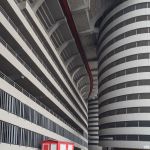
The story of the most iconic Italian stadium
We are talking about San Siro
March 15th, 2019
I'm not sure why among all the possible nicknames, at San Siro they attributed that of "Scala del Calcio". Without a doubt, however, the theatrical metaphor could not have been more appropriate, if your story was written by first violins like Rivera and Mazzola, virtuosos like Ronaldo and Kakà, directors like Sacchi and Herrera.
San Siro is the most beautiful stadium in Italy, never altered the pride of our football and the entire city of Milan.
Built in the 1920s and going through 3 major expansion works, it was the home of the European campaigns of AC Milan and FC Inter, of the nights of Italia90 and of concerts that made the history of Italian music. San Siro is the place where two different philosophies meet, two ways to live soccer and Milan, for a face to face match.

The first stadium
Piero Pirelli, president of AC Milan and son of Giovanni Battista, founder of the historic tire company, decided in 1925 that his team needed a new stadium, to leave the Arena Civica for good. To the north-west of Milan, in an area already used for sport due to the presence of the Hippodrome, on 1 August 1926, he started work on the construction of the San Siro. The project was entrusted to the engineer Alberto Cugini and to the architect Ulisse Stacchini, who had designed some newsstands of the Monumental Cemetery in Milan but above all the Central Station. In those years the prevailing and most influential architectural trend was the Art Nouveau, in Italy Liberty Style which was reworked with late-neoclassical elements. After only 13 months and with a total cost of two million liras, on 19 September 1926, the stadium was inaugurated, with a symbolic friendly between AC Milan and FC Inter. Only one of the 4 tiers, disconnected from each other, was covered by a canopy, while the great novelty was to be designed "in English style", that is, without the athletics track, designed specifically for football and therefore unique in comparison to other Italian stadiums.

From the beginning, the plant was called San Siro, not from the name of the neighborhood but from the church of S. Siro alla Vepra, near Piazzale Lotto, of which now only the apse remains, leaning against a villa.
The stadium will remain the property of Milan and Inter will continue to play at the Arena Civica, until the 47/48 season.
In 1935 the stadium came under the administration of the Municipality of Milan which decided to expand the stands, the corners were closed, now San Siro is a real arena, with the capacity of about 60 thousand spectators that made it the biggest stadium in the world, until 1950.
The 50s and the 60s
AC Milan and FC Inter between the 30s and 40s do not experience exciting seasons, also the fault of the Second World War, which brings the Rossoneri back to the Arena Civica, from '41 to '45. After the war, football became the sport of Italians par excellence and, in an atmosphere of renewed enthusiasm, we discussed what to do with the San Siro. Between those who suggested demolition and those who opted to move the court more into the city center, the Municipality of Milan decided to start a major renovation project. In 1955 the engineer Calzolari and the architect Ronca planned the construction of a second ring, reachable through a series of ramps that run along all the walls of the building. The project costs 750 billion Lire and totally changes the face of San Siro, inaugurating an extraordinary season for Milanese football.
Perhaps it is precisely in these years that the myth of the "Scala del Calcio" is born, stealing the name from the most famous of Milan's theaters. Certainly, San Siro becomes a stage, in which the actors are Maldini, Rivera, Mazzola, Liedholm, Schiaffino, Facchetti, Nordahl, Corso and Suárez. In less than twenty years, 4 Champions League and 12 Championships were brought to San Siro. In 1957 the stadium became the first Italian lighting installation, which allowed it to play even at night, while in 1967 the first luminous board was installed.
In 1980, what was now one of the symbols of world football was renamed to "Stadio Giuseppe Meazza", in homage to the player of Milan and Inter, who died a year earlier.
Italia 90
The history of San Siro and its architectural structure change markedly for the world championships in 1990. The architects Ragazzi-Hoffer and engineer Leo Finzi add what are today the true trademarks of the stadium: the 11 cylindrical towers with helical ramp allowing access to the third ring, on which a steel cover rests. The arena turns into a cage, which overlooks the field, creating a unique environment worldwide. The 37 ° slope of this part of the stand is indeed surprising, surpassed only by the last ring of the Mestalla of Valencia and by the fifth of the Santiago Bernabeu in Madrid.
The new plant reaches the capacity of over 80 thousand seats and is inaugurated during the opening round of the World Cup, on June 8, for the challenge between Argentina and Cameroon (0-1). At this time San Siro is, by detachment, the most beautiful stadium in Italy, with futuristic, authoritative and majestic architecture, a "spaceship in the Milanese suburbs" as it will be described by Time in 2009.

In the last 20 years, it has undergone continuous adjustments, from underground benches to restyling to meet the changes in UEFA regulations. But one of the most significant interventions for the aesthetics of the field and the spectacular nature of the game is the grass. The stadium's microclimate is not suitable for grass growth, causing rapid wear which for many years has necessitated interventions of refeed, which however did not solve the problem. Since 2012 it has therefore been decided to add 30% synthetic fibers to the natural grass.
Not only AC Milan and FC Inter owe a lot to San Siro, but also the Italian national team, which played 44 games without ever losing. The first time against Czechoslovakia, on 2 February 1927.

The last one was against Portugal, last October, after that unfortunate against Sweden. Excluding the European nights of Milan and Inter, Il Meazza hosted 4 Champions League finals, the first one with the Nerazzurri as protagonists, then in 1970, 2001 (Valencia-Bayern Monaco) and 2016 (Real Madrid-Atletico Madrid).
As well as for matches of the Italian national rugby team and for boxing matches, San Siro also hosted legendary concerts. The first ever was that of Bob Marley on 27 June 1980, but also David Bowie, Rolling Stones, Beyoncè

I keep perfectly as if it were an ancestral memory, the feeling that San Siro gives me every time I set foot on it. I firmly believe that this is not a personal matter, but a way that has that stage of being in awe, of reminding you that your feelings are unstable. The structure of San Siro is the one that the Romans used to increase the scenic impact on the great monuments. The narrow streets hide the rest of the urban landscape, suddenly opening up towards churches or theaters favoring an unexpected surprise effect. That's how San Siro is, and the ramps are the alleys, which up until the last moment only make you realize that something is about to happen.









































.png)


.jpg)













.jpg)



